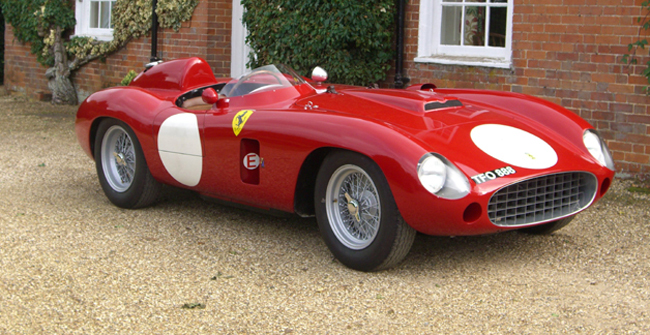
In the early 1950s, Ferrari shifted from using the compact Gioacchino Colombo-designed V12 engine in its smallest class of sports racers to a line of four cylinder engines designed by Aurelio Lampredi. Inspired by the success of the light and reliable 2.5 L 553 F1 car, the four cylinder sports racers competed successfully through the late 1950s, culminating with the famed 500 Mondial and 750 Monza.
One important stylistic difference between most four-cylinder Ferraris is that they lacked the hood scoops common on V12 models. The V12 cars used downdraft carburettors located centrally in the “valley” of the engine, while the inline-engined fours used side-draft units and thus did not need the hood scoops.
Ferrari Monza
- Also called: Ferrari TF., Ferrari Mondial
- Manufacturer: Ferrari
- Production: 1953–1957
- Predecessor: Ferrari 250 MM
- Successor: Ferrari 250 Testa Rossa
- Class: World Sportscar Championship
- Engine: Lampredi I4
1953
1953 was a breakout year for Ferrari, beginning with the new World Sportscar Championship series. The company augmented their traditional V12-powered 250 MM with the new 340 MM and 375 MM and introduced the new four-cylinder 625 TF and 735 S models. With this profusion of cars, Ferrari was able to sweep the first running of the sportscar championship.
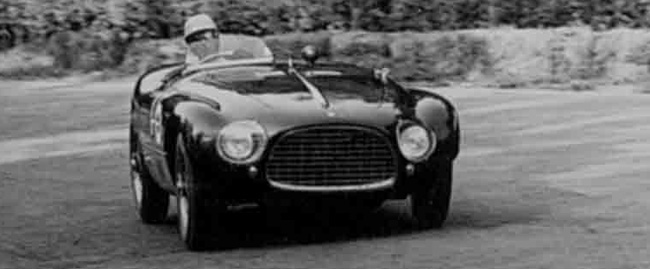
Ferrari 625 TF
The first four-cylinder closed-wheel sports racer from Ferrari was the 625 TF of 1953. Resembling the Vignale-designed 250 MM barchetta in most respects, the 625 TF used a 2.5 L (2498 cc/152 in³) straight-4 lifted from the 625 F1 car instead of the 250’s 3.0 L V12. It was a small car, with the same 2250 mm (89 in) wheelbase as the 250 but even lighter at 730 kg (1610 lb). The engine produced 220 hp (164 kW) at 7000 rpm and could push the little roadster to over 240 km/h (150 mph).
The lightweight car debuted at the hands of Mike Hawthorn at Monza on June 29, 1953. Although it could not keep up on the long straights at that track, Hawthorn still brought the car to fourth place at its debut.
A single closed 625 TF coupe, one of the last Ferraris designed and built by Vignale, was created in the Spring of 1953.
- Ferrari 625 TF
- Production: 1953
- Predecessor: Ferrari 250 MM
- Successor: Ferrari 500 Mondial
- Class: WSC racer
- Engine: 2.5 L (2498 cc) Lampredi I4

Ferrari 735 S
The same day that the 625 TF debuted, another car was fielded for Alberto Ascari. Sporting an enlarged 2.9 L (2942 cc/179 in³) engine, Ascari’s 735 S was more capable at Monza, leading the race until he collided with a 250 MM. The 735 S was a barchetta bodied by Carrozzeria Autodromo with recessed headlights, a drooping grille, and fender vents.
- Ferrari 735 S
- Production: 1953
- Predecessor: Ferrari 250 MM
- Successor: Ferrari 750 Monza
- Class: WSC racer
- Engine: 2.9 L (2942 cc) Lampredi I4
1954-1955
The 1954 and 1955 seasons were the heyday of the four-cylinder Ferrari sports racer. The company hit its stride, earning the World Sportscar Championship in 1954 and contending in 1955 despite the legendary Mercedes-Benz team. The Ferrari sports car lineup at the beginning of 1954 was made up of the 2.0 L 500 Mondial and 3.0 L 750 Monza. The team replaced the Mondial with the 500 TR later that year, and feverishly worked to hold off Mercedes-Benz, developing the larger 857 S and six-cylinder 118 LM and 121 LM. The planned V12 sports racer family, including the 250 Monza of 1954 and planned 410 S of 1955, were less notable.
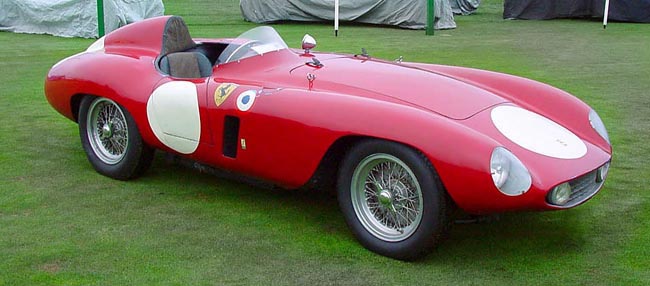
Ferrari 500 Mondial
The early experiments with Lampredi’s four-cylinder engine led to the creation of the famed 500 Mondial. Named to mark the world (“Mondial”) championships won by Alberto Ascari, the 500 Mondial featured a 2.0 L version of Lampredi’s four cylinder engine in a small and light body with an advanced suspension. The car debuted on December 20, 1953 at the 12 Hours of Casablanca driven by Ascari and Gianluigi Villoresi, placing second to a 375 MM.
The 500 Mondial’s 2.0 L (1985 cc/121 in³) engine was taken from the 500 F2 which won the world championship but was detuned to produce 170 hp (127 kW). It was extremely light at 720 kg (1590 lb) and handled well with a modern de Dion tube rear suspension.
The first 500 Mondials were coupes bodied by Carrozzeria Scaglietti, but Pinin Farina later created a series of barchettas. The Mondial remained competitive through the end of the decade, including an entry in the 1957 Mille Miglia.
- Ferrari 500 Mondial
- Production: 1954
- Predecessor: Ferrari 625 TF
- Successor: Ferrari 500 TR
- Class: WSC racer
- Engine: 2.0 L (1985 cc) Lampredi I4
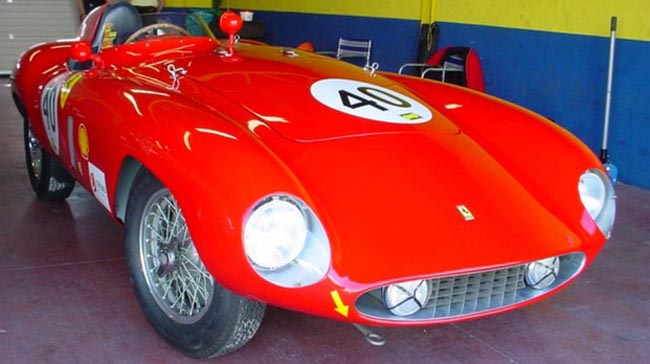
Ferrari 750 Monza
1954 saw the introduction of a new four cylinder sports racer, the 750 Monza. Sporting a three litre version of the 500 Mondial’s engine, the Monza was much more powerful, with 250 hp (186 kW) available, but barely heavier at 760 kg (1675 lb). The new-style body was penned by Pinin Farina and presaged the droop-nose look of the famed 250 GTO, but it was Scaglietti’s 750 Monza, with its faired-in headrest suggesting the flowing Testa Rossa that drew attention.
Mike Hawthorn and Umberto Maglioli piloted their 750 Monza to victory at Monza on its very first race, giving the car its name. Although they were strong on the track, the Monza was unable to hold off the Mercedes-Benz 300 SLR in 1955, allowing the Germans to seize the sports car championship that Ferrari claimed in 1954. The 750 Monza body was mated to the 3.0 L V12 to create the 250 Monza of 1954. This combination was not pursued, however.
- Ferrari 750 Monza
- Production: 1954
- Predecessor: Ferrari 735 S
- Successor: Ferrari 857 S
- Class: WSC racer
- Engine: 3.0 L (3000 cc) Lampredi I4
Ferrari 500 TR
As the 750 was introduced in 1954, the smaller 500 Mondial was replaced by another two liter car, the 500 TR. The first car to bear the famed Testa Rossa name, the 500 TR differed from the Mondial in many details. Among the most important was a coil spring suspension, a radical departure for Ferrari, as well as a synchronized transmission with a two-disc clutch. The 500 TR continued its predecessors tradition of light weight, coming in at just 680 kg (1500 lb), and this combined with the engine’s 190 hp (142 kW) to bring stirring performance to the car.
Scaglietti built most of the 500 TRs, with three also constructed by Carrozzeria Touring, and the design aped the 750 Monza including the faired-in headrest.
- Ferrari 500 TR
- Production: 1954
- Predecessor: Ferrari 500 Mondial
- Successor: Ferrari 860 Monza
- Class: WSC racer
- Engine: 2.0 L (1985 cc) Lampredi I4

Ferrari 857 S
The short-lived 857 S of 1955 was an attempt to hold off the strong Mercedes-Benz team, something the 750 Monza and 118 LM/121 LM were unable to do. An existing 750 Monza chassis received an enlarged version of Lampredi’s four, now displacing 3.4 L (3421 cc/208 in³) and producing 280 hp (209 kW). The car was not competative with the German team at the 1955 Tourist Trophy, so Lampredi went back to the drawing board for the next season.
- Ferrari 857 S
- Production: 1955
- Predecessor: Ferrari 750 Monza
- Successor: Ferrari 860 Monza
- Class: WSC racer
- Engine: 3.4 L (3421 cc) Lampredi I4
1956
With Mercedes-Benz pulling out of international sports car racing, the 860 Monza and new 290 MM showed well throughout 1956, bringing the sports car world championship home to Mondena again. This despite the fact that Jaguar’s new D-Type took the crown at the newly-restricted Le Mans and Maserati’s 300 S took the Nürburgring race.
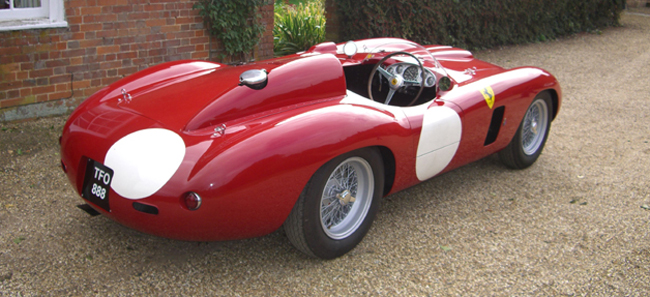
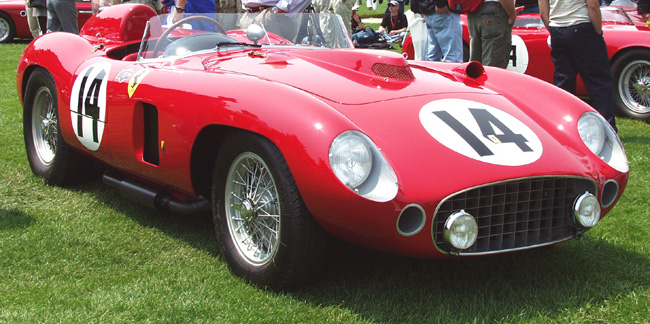
Ferrari 860 Monza
Although little changed on paper from the 857 S, the 1956 860 Monza was much more competative in international sports car racing. The engine was reworked with 102 mm (4 in) by 105 mm (4.1 in) dimensions for a total of 3.4 L (3432 cc/209 in³), though power output remained at 280 hp (209 kW). The wheelbase was lengthened by 100 mm (3.9 in) to 2350 mm (93 in), but a new front coil spring suspension, as on the 500 TR, allowed the 100 kg (220 lb) heavier car to handle well.
- Ferrari 860 Monza
- Production: 1956
- Predecessor: Ferrari 857 S
- Successor: Ferrari 250 Testa Rossa
- Class: WSC racer
- Engine: 3.4 L (3432 cc) Lampredi I4
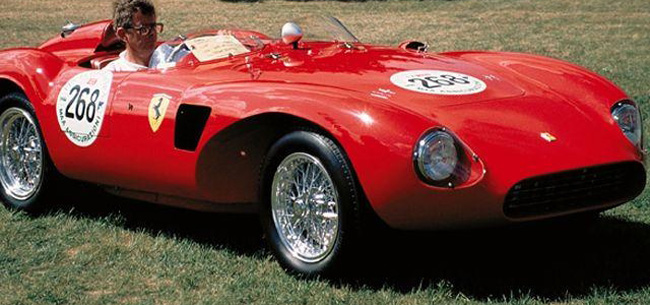
Ferrari 625 LM
After the 1955 Le Mans disaster, the ACO reduced engine size and restricted prototype entries for the 1956 24 Hours of Le Mans to control the speed and danger of the race. Ferrari could not enter its 1956 3.4 L 860 Monza and 3.5 L 290 MM in race, so it instead modified three 500 TR barchettas to take the larger 2.5 L engine, and entered them as the 625 LM. The engine was only slightly modified from the 625 F1 with compression reduced to 9:1 and two Weber 42DCOA carburettors used. Of the three, only the car of Gendebien/Trintignant finished, placing third to the new Jaguar D-Type.
- Ferrari 625 LM
- Production: 1956
- Predecessor: Ferrari 121 LM
- Successor: Ferrari 335 S
- Ferrari 250 Testa Rossa
- Class: Le Mans prototype
- Engine: 2.5 L (2498 cc) Lampredi I4
1957
Ferrari handed off the four-cylinder sports racer line to customers at the end of 1956, choosing to focus on its own attention on the V12-powered 312 and 335 S cars.
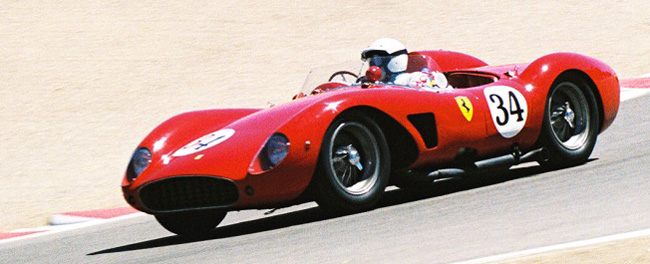
Ferrari 500 TRC
The 1956/7 500 TRC was a massaged version of the successful 500 TR of the previous year. In keeping with the new C-section regulations, Ferrari widened the cockpit, added doors, fitted a windscreen, and even added a stowable convertible top. It rode on the longer 2350 mm (93 in) wheelbase of the 860 Monza and featured coil springs all around, though the live axle in the rear was retained rather than the more modern de Dion tube. The 680 kg (1500 lb) car’s 190 hp (142 kW) made it quite capable, and even though it was never a works car, a 500 TRC claimed a class win at the 1958 Targa Florio.
- Ferrari 500 TRC
- Production: 1957
- Predecessor: Ferrari 500 TR
- Class: WSC racer
- Engine: 2.0 L (1985 cc) Lampredi I4
Ferrari Lampredi Engine
Aurelio Lampredi designed a number of racing engines for Ferrari. He was brought on to hedge the company’s bets with a different engine family than the small V12s designed by Gioacchino Colombo. Lampredi went on to design a number of different straight-4, straight-6, and V12 engines through the 1950s, and it was these that would power the company’s string of world championships that decade. All were quickly abandoned, however, with the Dino V6 and V8 taking the place of the fours and sixes and evolution of the older Colombo V12 continuing as the company’s preeminent V12.
I2
Enzo Ferrari and Lampredi were interested in creating extremely reliable engines for racing use. In 1955, after seeing the success of Lampredi’s straight-4 engines, the pair considered a straight-2 engine for the slowest racing courses. Lampredi built a prototype with 4 valves per cylinder and 2.5 L (2493 cc) of displacement. It produced 175 hp (130 kW) on the test bench, but broke the crankshaft due to poor balance. The project was shortly abandoned in favor of more-conventional I4 engines.
I4
Lampredi designed a straight-4 engine for Formula Two use. This was later adopted for Formula One and sports car racing cars through the 1950s. The original 2.0 L engine of 1951 would prove to be the longest-lived, continuing through 1957 in various cars.
- Ferrari Lampredi Straight-4
- Manufacturer: Ferrari
- Production: 1951–1957
- Predecessor: Colombo V12
- Successor: Dino V6
- Class: DOHC 2-valve Straight-4
- Engine:
-
-
- 2.0 L (1985 cc/121 in³)
- 2.5 L (2498 cc/152 in³)
- 2.9 L (2942 cc/179 in³)
- 3.0 L (3000 cc/183 in³)
- 3.4 L (3421 cc/208 in³)
- 3.4 L (3432 cc/209 in³)
-
-
500
The initial engine was a 2.0 L (1985 cc) unit with a 90 mm (3.5 in) bore and 78 mm (3.1 in) stroke. This engine was the first Ferrari four-cylinder, appearing in 1951 in the Ferrari 500 F2 entrant in Formula 2. The aluminium engine produced 165 hp (123 kW) with four Weber 45DOE carburettors, with power growing in 1953 to 185 hp (138 kW) with two 50DCOA carbs. It was a high-tech marvel for the time with dual overhead camshafts pushing 2 valves per cylinder and twin-plug ignition.
An entirely different “500” four cylinder appeared in 1953 in the 553 F2 car. This time, bore was 93 mm (3.7 in) and stroke was 73.5 mm (2.9 in) for a total of 1997 cc. Two Weber 52DCOA3 carbs produced 190 hp (142 kW).
The original 1951 Formula 2 engine was resurrected for the World Sportscar Championship in 1953 and the 500 Mondial. With lower compression and two Weber 45DCOA3 carbs, it produced 170 hp (127 kW). The same engine, now at 190 hp (142 kW), was used in the famous 500 TR. The “red head” cylinder head lent its name to the car, the first Testa Rossa. Another TR with this engine, the 1956/1957 500 TRC, was produced for customers to race.
Applications:
- 90 mm (3.5 in) by 78 mm (3.1 in)
– 1951–1953 Ferrari 500 F2
– 1954 Ferrari 500 Mondial
– 1954 Ferrari 500 TR
– 1957 Ferrari 500 TRC - 93 mm (3.7 in) by 73.5 mm (2.9 in)
– 1953 Ferrari 553 F2
625
The 500 F2 car was reworked in late 1953 to become Ferrari’s 1954 entrant in Formula 1. The engine was bored and stroked to 100 mm (3.9 in) by 79.5 mm (3.1 in) for a total of 2498 cc of displacement. The F1 car, with 13.1:1 compression and two Weber 50DCOA3 carbs, pumped 260 hp (194 kW) from this powerplant. The oversquare 200 F2 engine reappeared again in the 1955 555 F1.
This car would quickly evolve into the 1954 625 F1, though with a much-changed engine. This time, 94 mm (3.7 in) by 90 mm (3.5 in) dimensions were selected, though the total displacement of 2498 cc remained unchanged. Output was now 250 hp (186 kW).
The first application of Lampredi’s four-cylinder engine outside Formula 1 and 2 was this same 2.5 L (2498 cc) unit in the 1953 625 TF. The aluminium engine produced 220 hp (164 kW) with 2 Weber 50DCOA3 carburettors. This version was used in the 1953 625 TF. After the Le Mans disaster, the 2.5 L I4 was resurrected for the 1956 625 LM car. Output was rated at 225 hp (168 kW).
Applications:
- 100 mm (3.9 in) by 79.5 mm (3.1 in)
– 1953 Ferrari 553 F1
– 1955 Ferrari 555 F1 - 94 mm (3.7 in) by 90 mm (3.5 in)
– 1953 Ferrari 625 TF
– 1954 Ferrari 625 F1
– 1956 Ferrari 625 LM
735
A big-bore version (102 mm) was also produced. Displacement was now 3.0 L (2942 cc) with 102 mm (4 in) bore, though the 90 mm (3.5 in) stroke was retained. Output nudged up to 225 hp (168 kW) with two Weber 50DCOA carbs.
Applications:
- 1953 Ferrari 735 S
750
The bore of the Lampredi I4 was nudged up to 103 mm (4.1 in) for the 3.0 L (2999.62 cc) unit used in the 1954 750 Monza. Dual Weber 58DCOA3 carbs pushed out 250 hp (186 kW).
Applications:
- 1954 Ferrari 750 Monza
857
For 1955, the “type 129” engine debuted in the experimental 857 S displacing 3421 cc.
Applications:
- 1955 Ferrari 857 S
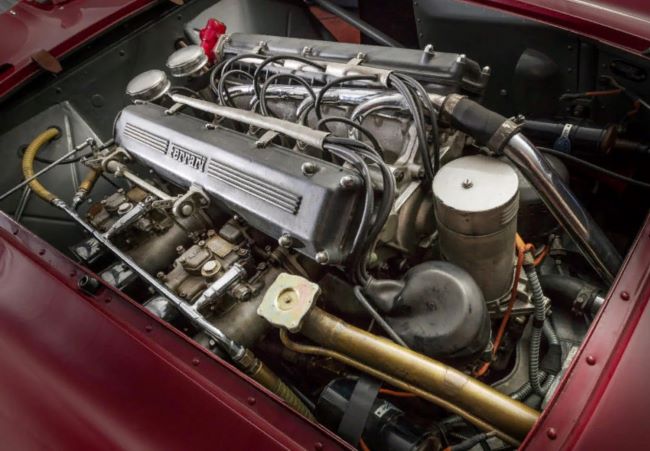
860
The Type 129 engine was finally raced in the 1956 860 Monza with 280 hp. Bore was the same 102 mm (4.0 in) as the big-bore four, but stroke was now 105 mm (4.1 in) for a total of 3432 cc. These cars placed first and second at Sebring and came second and third at Le Mans that year.
Applications:
-
- 1956 Ferrari 860 Monza

I6
For the 1955 735 LM, Lampredi modified the big-bore 1953 I4 into a straight-6. Displacement was 4.4 L (4412 cc) from 102×90 mm cylinders. Triple Weber 50 DCOA/3 carbs pushed out 300 to 350 hp. With this power, the 735 LM could hit 280 km/h on the Mulsanne straight at Le Mans. A smaller version was used that same year in the 376 S sports car. It used the same 90 mm stroke and 94 mm bore as the original Lampredi Formula One engine and produced 280 hp.
V12
After little luck in Formula 1 with the supercharged Colombo V12, Ferrari moved to natural aspiration. The task of designing an NA V12 for Formula 1 use fell to Aurelio Lampredi, who designed a 3.3 L (3322 cc) unit.
Like the Colombos, Lampredi engines found their way into road cars as well. The 1952 342 America and MM were first with big 4.1 L (4102 cc) engines producing 200 and 200 hp (149 and 224 kW). Lampredi engines moved to the 250 with the 1953 250 Export. Unlike the earlier engines with their undersquare 80 mm (3.1 in) by 68 mm (2.7 in) bore and stroke, the 250 used square 68 mm (2.7 in) dimensions for 3.0 L (2963 cc) total. Power was impressive at 220 hp (164 kW).
The big America engine was made even larger for the 1956 410 Superamerica. Now with an 88 mm (3.5 in) bore, it displaced 5 L (4962 cc) and produced 340 hp (254 kW). The same engine was used in 1964’s 500 Superfast.
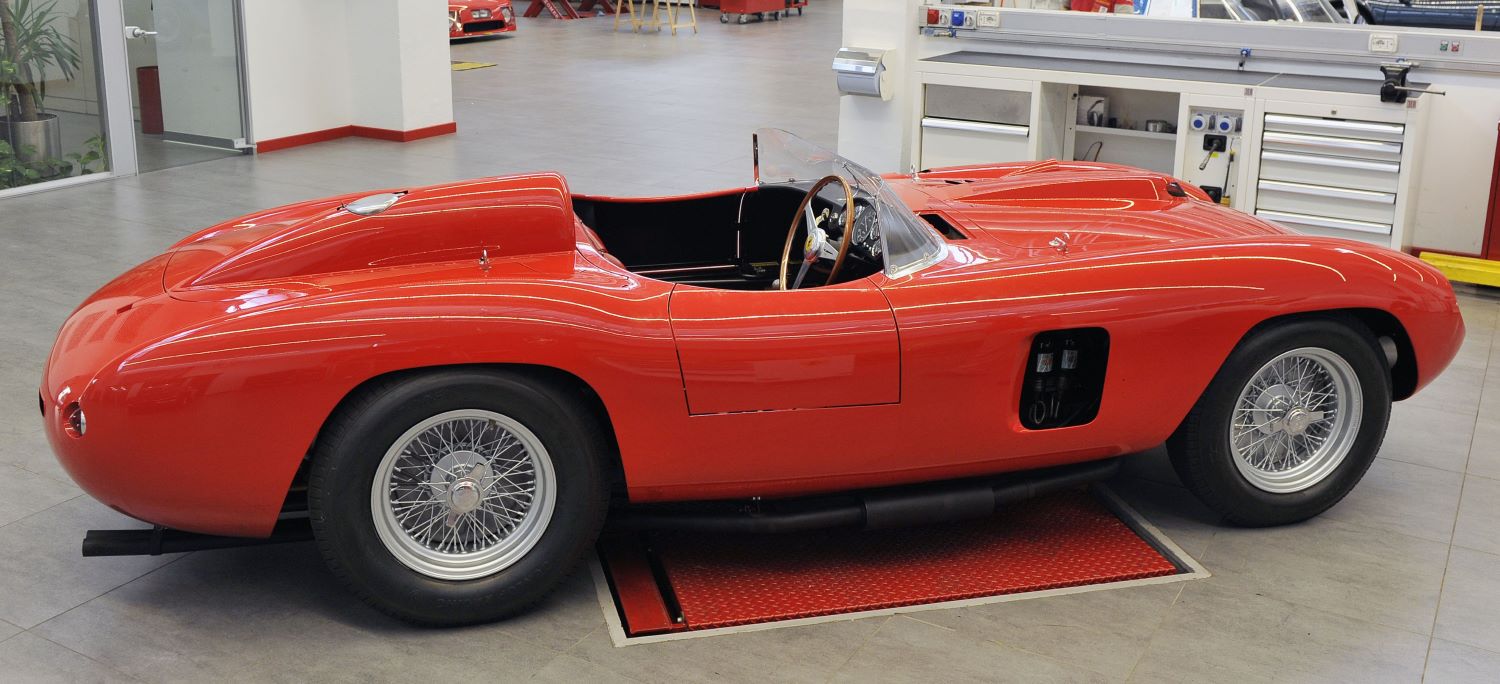
FERRARI 290MM – A LEGENDARY CAR
Maranello, 17th October 2014 – Fangio, Castellotti, De Portago, Von Trips, Phil Hill, Stirling Moss. Motor racing legends that shared not just races, victories and marques, but also a specific Ferrari, the 290 MM. We’re not talking about a model but an actual individual car – engine, bodywork and chassis number – which a few months back arrived at the Ferrari Classiche department for restoration.
On this car, born as 860 Monza , Enzo Ferrari decided to swap the latter’s 4-cylinder engine with a 12-cylinder, creating the 290 MM. In its first two years, it was driven by an astonishing list of champions in a hugely diverse array of races from the Mille Miglia (hence the MM moniker) to the Targa Florio, the Swedish Grand Prix and the 12 Hours of Sebring.
In 1957, it was sold to Belgian driver Jan De Vroom who was, however, involved in a serious accident in it in Sweden. The car was repaired and the body radically modified. In fact, at De Vroom’s behest the original nose was replaced with a longer, more prominent pontoon fender-style one, inspired by the famous Testa Rossa.
The 290 MM has now been lovingly restored to its original 1956 look and shape. The workers in the Ferrari Classiche department already know when it will be completely finished and ready to return to its legitimate owner and they’re missing it already.

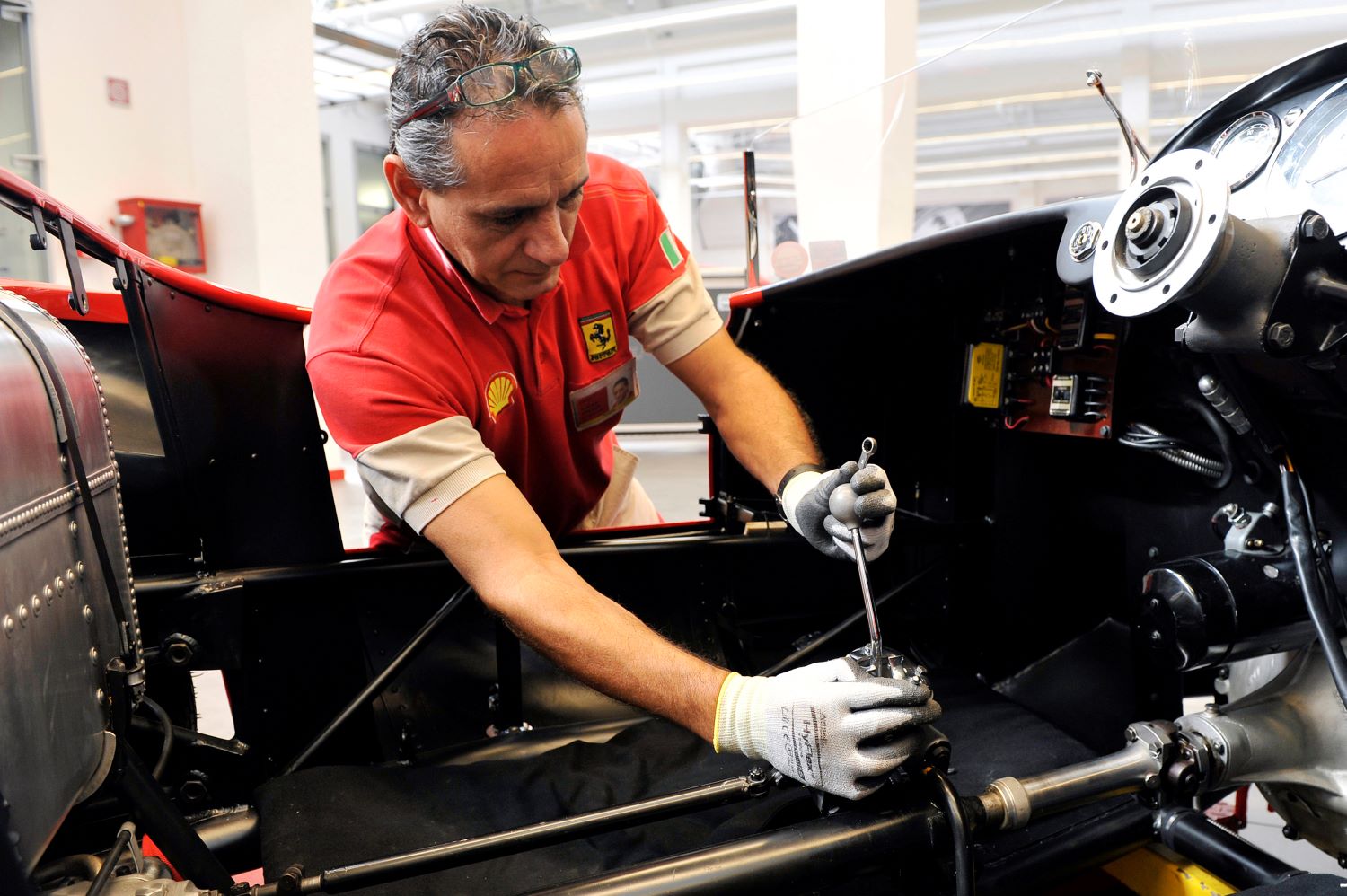
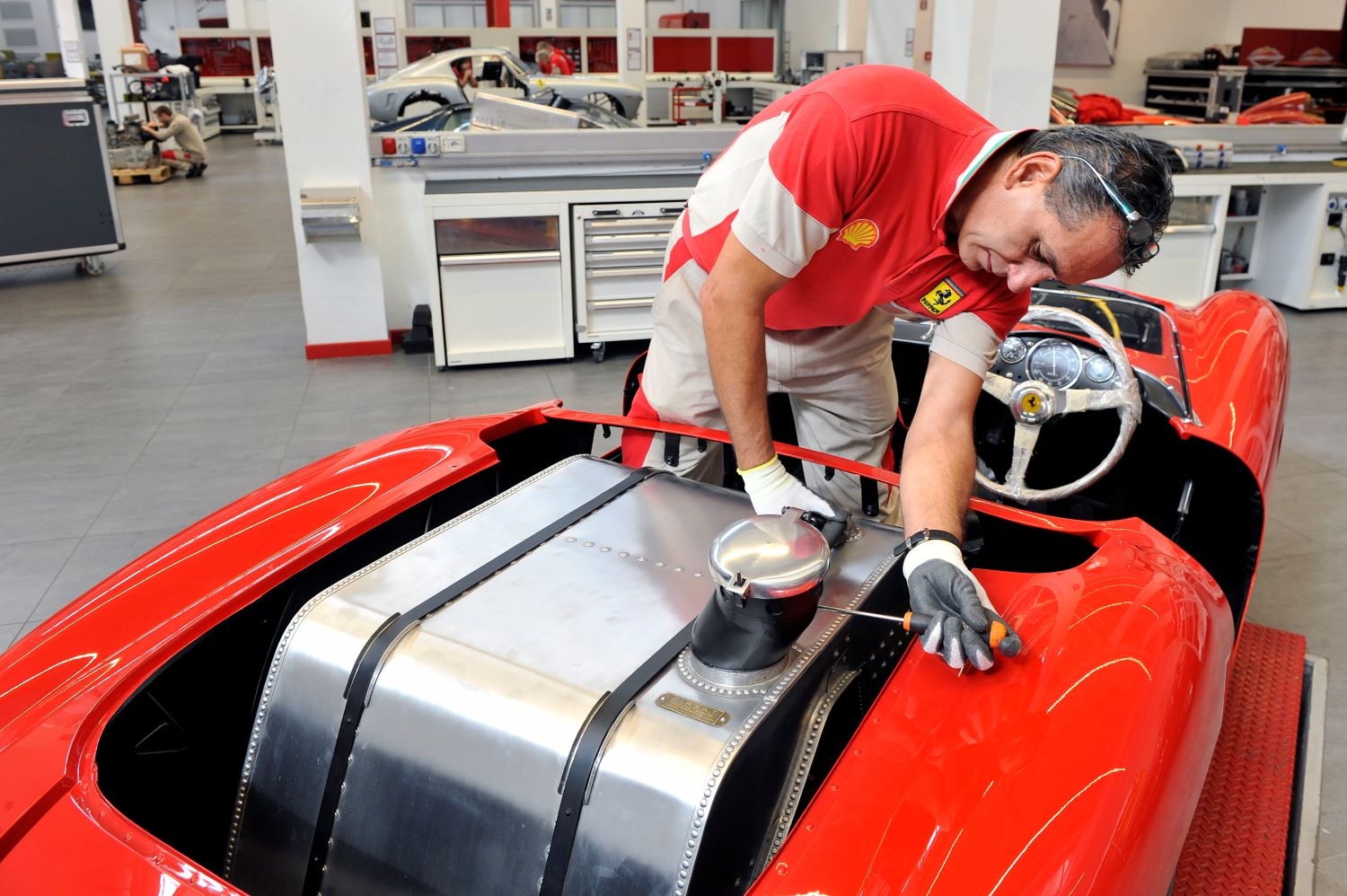
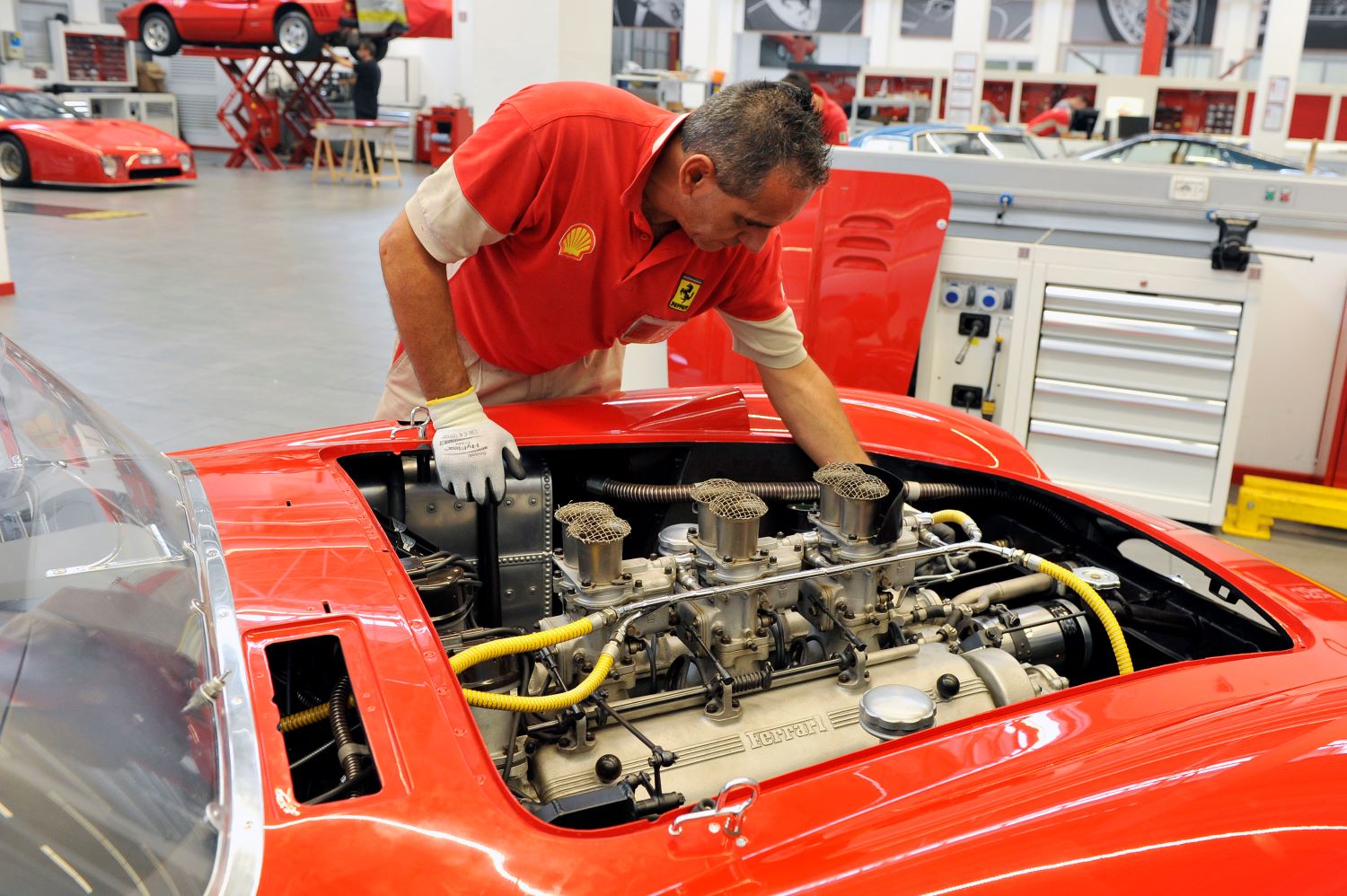
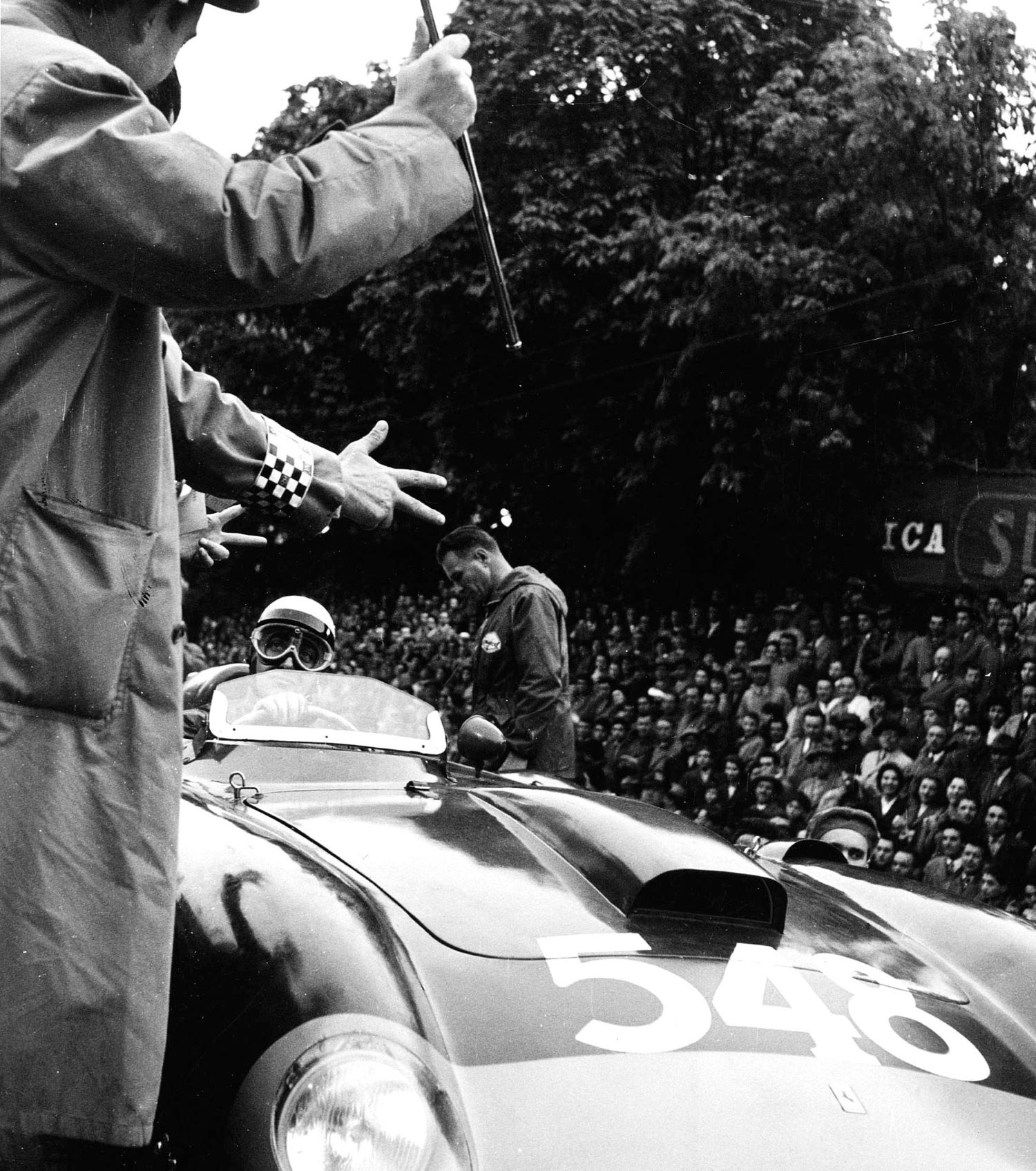

You must be logged in to post a comment.